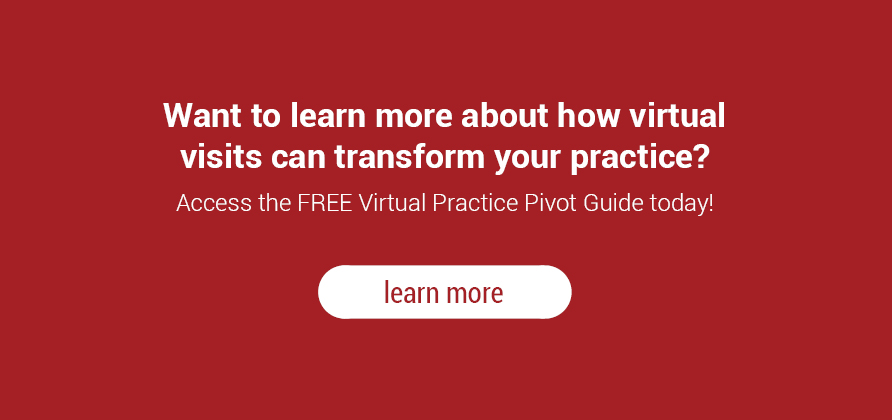The coronavirus has skyrocketed the demand for health care while simultaneously amputating its main arm of delivering the care itself. People desperately want to see trained professionals; however, they are equally afraid to see them in-person. And because
face-to-face individual appointments had been the comfortable and seemingly secure way of seeing patients pre-COVID-19, many smaller medical offices are suddenly disoriented and struggling to figure out how to pivot to remain solvent these days.
Did you ever think of what most doctors' offices don’t employ? IT specialists. Small, independent practices generally do not house an IT employee ready to take over a sudden demand for expanded telehealth services like larger institutions
do. The result is many of us are having difficulty ramping up our telehealth systems and workflows. Even if we could master this technology quickly, most small practices have no more than two or three months of operating expenses in reserve. So, what
else are we dealing with today?
According to the CEO of Medical Group Management Association (MGMA), a leading authority in practice management optimization within the health care industry, medical practices are experiencing a 30% to 75%
decrease in patient visits. Lower patient volume has resulted in a 40% to 50% reduction in primary care revenues prompting many independent practices to consider either reducing physician compensation and/or laying off staff to survive.
Fortunately,
there is a novel and viable solution that is working in this environment and has decades of success stories to promote it as a path to access and care. Enter lifestyle-based group medical appointments (aka group visits). You see, prior to COVID-19,
there was another suite of epidemics that was ravaging the clinical and economic foundations of our health care system and country: complex, chronic disease epidemics like heart disease, obesity and diabetes.
Although there wasn’t
the same national-news-type urgency to these insidious and potent killers, they created a demand for primary care and specialist appointments that outweighed the system’s ability to optimally provide them. Luckily, progressive medical institutions
of all sizes, such as the world renowned Cleveland Clinic’s Center for Functional Medicine down to cozier practices like Dr. Christopher Mote’s, have employed the group visit methodology and shown improved outcomes at lower overall costs
to the patient for similar care.
The simple secret to their successful ability to serve more patients more efficiently and make more money: They leverage time with groups. These innovative practices gather eight to 20 patients in a room
(e.g. onsite in a lobby or virtually through a videoconferencing room) and have an extended 90-minute medically prescribed group visit together.
The first 30 minutes are spent discussing important information a provider commonly explains
during an individual appointment. You know, the education and connections you find yourself sharing over and over with nearly all patients at some point, such as the importance of microbiome, inflammation, detoxification, stress, etc. The next 60
minutes is where the magic happens. The group visit facilitator (e.g. provider, health coach, etc.) spends this time tailoring the information to empower each participant, answering questions and having the group share successes and struggles around
implementation.
Overwhelmingly, the evidence shows that the group format actually produces a more knowledgeable patient who not only understands their condition, but also the key actions they can take to reduce or reverse it. And although you may be convinced
that your expertise and individual attention during a one-on-one appointment is the gold standard for improved outcomes, the evidence just doesn’t support it for chronic complex disease. Apparently, what’s missing in an individual appointment
is the group!
So, what does this all mean? We find ourselves in a time period that recommends social isolation, and yet people still need to be connected to other people to heal. Patients need peers, health care providers and a technology
that connects them virtually to fill the gaps the pandemic has created. Gaps include, but are not limited to:
- Exposure reduction through social distancing or quarantine based on individual risk factors will likely continue through 2020 in some format.
- Reducing the severity of underlying health conditions (e.g. diabetes, inflammatory disorders, mental health concerns, etc.) can improve the odds of survival if exposure and infection occur.
- The highest-risk populations may be unable/unwilling to visit an office until herd immunity, vaccine and/or treatment is optimized.
- Group medical appointments are underutilized due to misperceptions, including: implementation is cumbersome, revenue potential is limited, and it’s more of a lecture than a true medical appointment.
Gaps can be filled with these solutions while we learn more:
- Telehealth as a form of health care delivery is being catapulted forward due to this pandemic. “Coronavirus or not, this may be just the impetus needed to prepare for what’s going to be the future of health care anyway,” says Ron Holder, COO of MGMA. And with fewer patients coming in, he adds, “This is your opportunity to try some of the things you may have been wanting to try but hadn’t had the time.”
- Functional and integrative medicine providers are exactly trained to address the epidemic of underlying health conditions, which is at the root of most morbidity and mortality associated with the pandemic. We have the answers that conventionally trained doctors may not even know how to explore right now. That’s why they must solely focus on exposure reduction, vaccines and pharmaceutical treatments.
- Many of our most vulnerable populations of baby boomers and the elderly figured out how to use smartphones and technology because they were committed to connect with their loved ones. Who says they can't be trained to use simple, user-friendly telehealth platforms? They need us to believe they can do it. Actually, we need us to believe we can do it.
- Group medical appointments are the solution of yesterday’s, today’s and tomorrow’s health care needs. They provide the missing piece humans will always need to heal: social connection and self-empowerment. With turnkey solutions for implementation, 200% to 600% documented increases in productivity, and a proven operational format that increases patient access and reduces patient wait times, the real question for modern day health care offices is, “When will I start doing group visits?”
Here’s a simple analogy. Blockbuster had the resources, and had it been smart enough to invest some of those resources to go online, they would have decimated Netflix. In retrospect, virtual conveniences like Netflix seem simple and obvious. And
yet, Blockbuster was the slow giant that failed to innovate. The future belongs to those who anticipate society’s needs and deliver them for simple consumption. Virtual group medical care is lining up to be the future of health care delivery.
The question is, who will you choose to be…the slow giant or the nimble innovator?

Shilpa P. Saxena, MD is a Board-Certified Family Practice physician whose passion and purpose come to life through sharing her innovative patient education and practice management solutions in her classic ‘keep it simple’ style. She serves as Faculty with the Institute for Functional Medicine and the Arizona Center for Integrative Medicine. She also serves as the Clinical Expert at the Lifestyle Matrix Resource Center for the CM Vitals Program. Dr. Saxena is an expert in the Group Visit medical model, creator of Group Visit Toolkits, and co-author of The Ingredients Matter: India.




